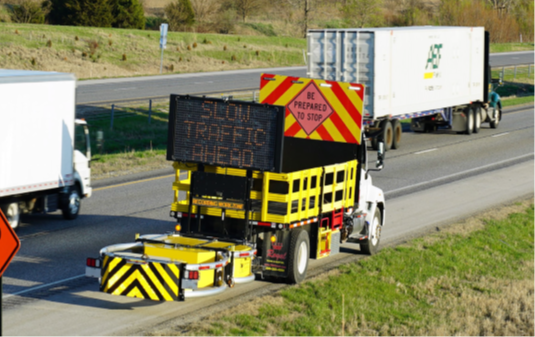Trial Deployment in Indiana Evaluated Safety Impact of Commercially Available In-vehicle Communication Alerts.
Indianapolis, Indiana, United States
Gary, Indiana, United States
West Lafayette, Indiana, United States
Plymouth, Indiana, United States
Evaluating the Impact of Vehicle Digital Communication Alerts on Vehicles
Summary Information
Methods for communicating the presence of maintenance activities and work zones traditionally include fixed signs, but advanced in-vehicle technologies (i.e., directly integrated into the vehicle or via an application running on a mobile phone) provide increasingly more opportunities to improve communication to motorists. Indiana Department of Transportation (INDOT) conducted statewide trial deployments that leveraged the extensive telematics currently deployed on INDOT vehicles to determine the safety impact of in-vehicle communication alerts. Commercially available alert devices were installed on a total of eight vehicles from May to August 2020: three vehicles in Indianapolis, two in Gary, one in Plymouth, one in West Lafayette, and one that was active statewide. The installation continued and as of June 28, 2021, 15 Hoosier Helper emergency response vehicles offered by INDOT were equipped with the alert devices and approximately 20 Hoosier Helper trucks served as a control group. This study also conducted two detailed case studies showing the impacts of the alert system along U.S. Interstate Highways 65 and 69. Telematics records, which were updated every two seconds, were collected. Driver acknowledgement of in-vehicle alerts and hard braking data were used to evaluate the safety and overall effectiveness of the alerts.
- Use in-vehicle alerts to complement roadside signs. Alerts displaying the driver’s current travel speed compared to the posted speed limit may lead to a reduction in speed, increasing traffic safety.
- Place queue trucks in front of a work zone to reduce the number of hard braking events and crash risk. Case studies proved that hard braking events decreased between situations without queue trucks (29) and with queue trucks (3), an 87 percent reduction. Although it is not clear how much of this reduction was due to the visibility of the truck compared to the in-vehicle alert, the reduction of hard braking was well received, indicating improvement in driver and traffic safety,
- Work collectively with the navigation and automotive OEMs to ensure that in-vehicle communication alerts do not distract drivers. There is a significant opportunity for transportation agencies to partner with the connected vehicle sector to provide important information regarding maintenance activities and the presence of emergency vehicles on the roadway. However, commercially available mobile apps may already alert drivers of traffic conditions and the presence of public safety vehicles. Transportation agencies are suggested to work collectively with the connected vehicle sector to avoid introducing new in-vehicle alerts that may distract drivers and reduce traffic safety.
- Utilize two queue trucks in road segments with rapidly developing queues. Two queue trucks can be helpful in environments where there are rapidly developing queues and it is not feasible due to policy or road geometry to back up. One queue truck can be placed in front of a work zone while the other can be placed in the work zone, but it is recommended that both trucks are placed in front.

